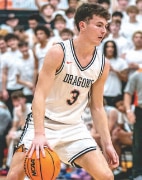For love of food
Keeping a teen athlete fueled has turned into a science
Everyone’s aware of how Michael Phelps ate 12,000 calories a day before competing in the Olympics. Lance Armstrong is said to eat between 6500 and 7000 calories a day. J. J. Watts, defensive end for the Houston Texans, eats 9,000 calories a day and says he often has to force himself to eat to maintain his diet.
Ask most people what to eat to be “healthy” and you’ll get pretty much the same answer every time. Eat lots of vegetables, cut back on butter and fat, don’t smother everything with cheese, and eat chicken breast. Trying to lose weight? Cut carbs. Trying to gain muscle? Eat more protein. Simple, right?
Well, here’s the thing - for athletes, a lot of that advice goes straight out the window. Reports vary, but the Academy of Nutrition and Dietetics states that teenage male athletes need between 3,000 and 4,000 calories a day, while female athletes need to consume between 2,200 and 3,000 calories per day on average.
Compared to the monster numbers above, that might not sound like much. Consider this, though: an entire pepperoni pizza from Dominos, according to the USDA, is only 2,478 calories, while a Bic Mac with a small fry is only 770 calories. Both, together, would come to an estimated 3,200 calories, just past the lower end of the estimated calories needed for a male athlete. In fact, they could have another Big Mac, with another small fry, and still be under the higher estimate.
That’s insane, but it gets even more crazy.
Some teens, depending on their activity level, may need as much as 5,000 calories per day. That’s two whole pizzas.
People can’t just go around eating pizzas and burgers for everything though. At least, not if they want to live past 35. Calories aren’t everything.
For a 3,000 calorie diet, it’s recommended that 45 to 65 percent of it be made up of carbohydrates. At four calories per gram, that’s 337.5 to 487.5 grams of carbs. Keeping with the pizza example, an entire pepperoni pizza only contains 289 grams of carbohydrates. Even if you’re an athlete, pizza everyday is probably not the best option. Sorry.
Better carbs are things like brown rice, whole grain bread, quinoa, etc. Even then, though, quinoa only has 39 grams per cup, brown rice 45, and a slice of whole grain bread has only 12. To get to 337 grams, a person would have to eat 28 slices.
The other major builder is protein. Protein is what your body uses to build muscles and athletes are supposed to consume between .45 and .68 grams per pound of body weight.
But what does all that mean in practice? What do actual student athletes eat?
Craig Owens, the strength and conditioning coach for Anderson County, says that it depends.
“For the smaller guys, they usually come in just under 3,000 calories, but for the bigger guys, they’re definitely pushing over it. If they get higher, say 5,000 calories a day or something, then they’re gonna get really huge really quick and it won’t be beneficial to them.”
“We have a lot of trouble with keeping weight on wide receivers and corner backs. The issue I find with little guys is they never realize how little they’re eating. They think they’re eating a lot… but they’re not.”
“For the bigger guys, it’s all about the quality of the food they’re getting. They’re already eating enough, it’s just about pulling them off the processed meats, the sweets, all that, and replacing it with rice, pasta, potatoes, that kind of stuff.
Not everything is calories, though. Protein, carbs, sugars, fats, they’re all part of eating. Owens said he stresses one of those more than any other, though.
“Big thing I preach to my guys is complex carbohydrates. I’m not against the low-carb diets, it’s just not a diet that’s conducive to athleticism. The human body is at its best with the complex carbs. With protein, if my bigger guys can get 160-15 grams of protein, I’m happy, but with the smaller guys, I want them getting closer to that 1 gram per pound of body weight.”
The final thing Owens stressed is avoiding sports drinks.
“I’m not a fan. Kids are using them as a substitute for hydration. Water is your hydration. [Sports drinks] don’t contain enough electrolytes to replenish what your body is sweating out, so you’re better off drinking water and getting plenty of food to replenish those electrolytes.”
So it’s certainly not as dramatic as Michael Phelps or Lance Armstrong, but the players certainly eat a lot, still. Considering the average adult diet is close to 2,000 calories a day, it’s still impressive that they need that much more nutrition.

